At certain places on the Sabine River, I try to keep an eye out for evidence of the ferries that once allowed people (and wagons and livestock) to cross the river before bridges became an option.
If the water in the Sabine wasn’t so brown and murky, you could probably locate some of the old ferries decaying on the riverbed, where they sank after being abandoned in the late nineteenth and early twentieth centuries. I heard about them from my friend and collaborator Jacob Botter, whose ancestors operated a ferry at the end of what is now Waldons Ferry Road, a dirt trail in rural Harrison County. His great-great-great-great-grandpa (give or take a great or two) ran a rope from one side of the river to the other and used the rope to pull himself across whenever a paying customer wanted passage.
I’m not sure when that ferry ceased to exist, but Gaines Ferry, the last ferry on the Sabine River, operated until 1937. It transported travelers along the old Camino Real, where Texas Highway 21 meets Louisiana Highway 6. The ferry was replaced by a bridge, which was inundated by the creation of Toledo Bend Reservoir a little more than half a century ago.
I was reminded of the Sabine River ferries when my friend Sean Kimmons shared photos from his recent crossing of the Rio Grande. Sean and his parents loaded their car onto a ferry in Los Ebanos, Texas, and were pulled across the river by a team of men tugging a rope stretched from one bank to the other.
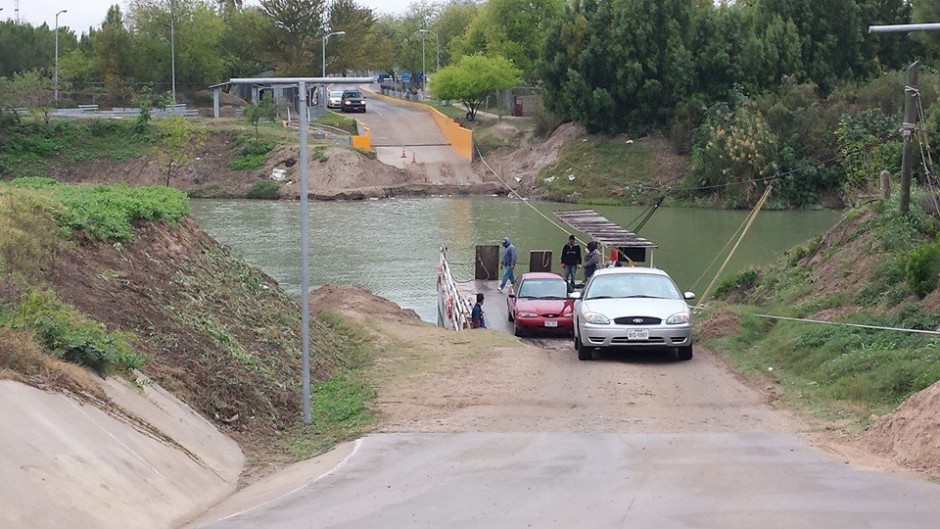
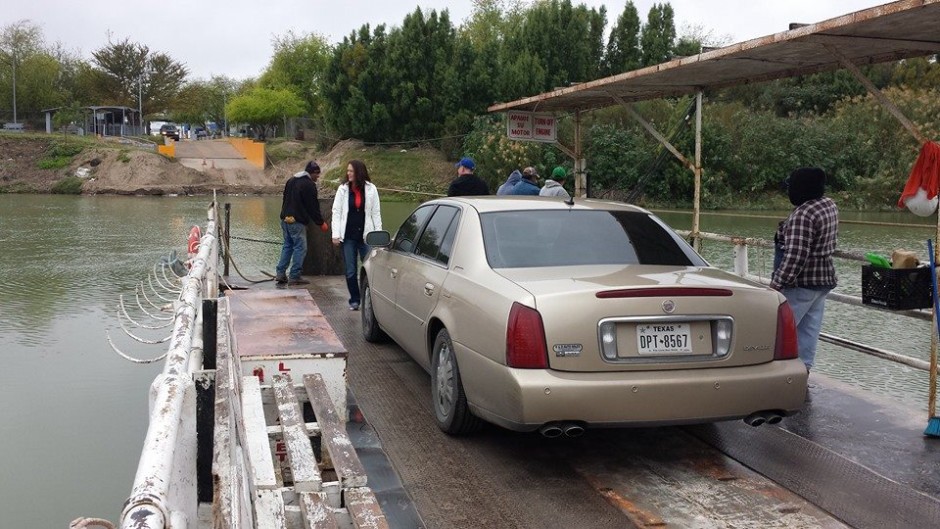
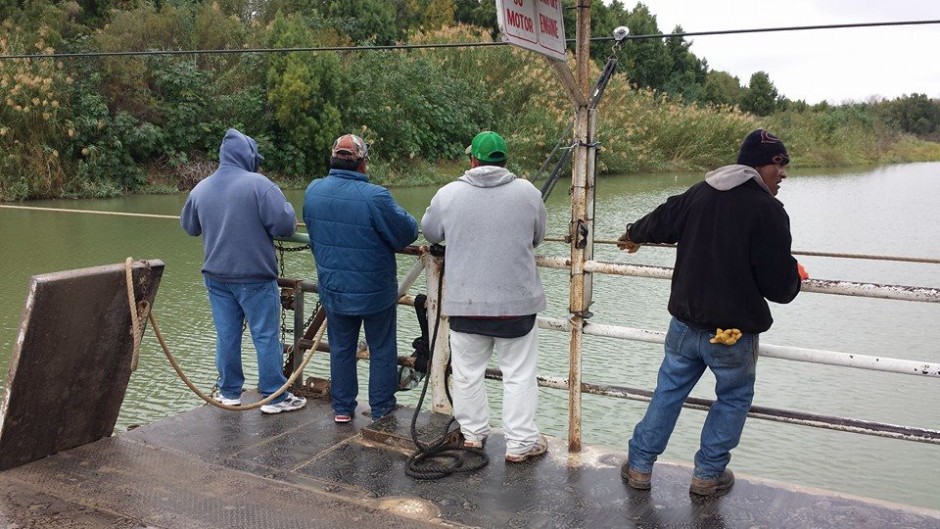
According to the Texas Department of Transportation, the Los Ebanos Ferry is the only remaining hand-pulled ferry on the Texas-Mexico border.
The Los Ebanos Ferry is a popular tourist attraction since it is the only remaining hand-pulled ferry on the U.S.-Mexico border. It can accommodate only three cars and 12 pedestrians at one time.
The crossing is also known locally as Los Ebanos-San Miguel Camargo, Ferry Gustavo Díaz Ordaz and Ferry Díaz Ordaz-Los Ebanos.
Although the crossing has been in operation since the 1950s, the current ferry has been operating since 1979. It was recognized with a state historical marker in 1975.
And here’s a photo of a Sabine River ferry taken in 1916.
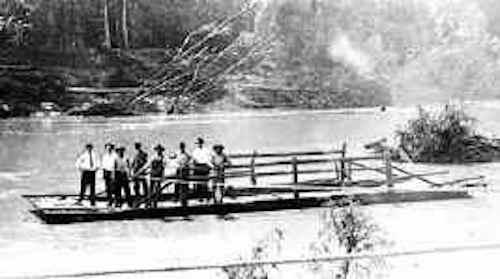
Here’s a random video that shows how the Los Ebanos Ferry works.
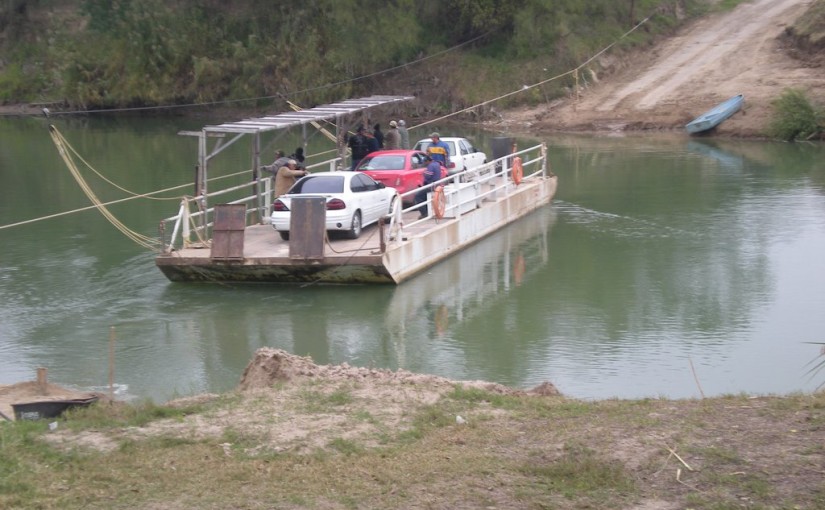
9,064 responses to “Hand-pulled ferries across the Sabine and Rio Grande”
Wonderful work! This is the type of info that should be shared around the web. Shame on the search engines for not positioning this post higher! Come on over and visit my web site . Thanks =)
I just couldn’t depart your website prior to suggesting that I really enjoyed the standard information a person provide for your visitors? Is going to be back often to check up on new posts
Hi, I do believe this is a great website. I stumbledupon it 😉 I’m going to return once again since i have book-marked it. Money and freedom is the greatest way to change, may you be rich and continue to guide others.
I have observed that over the course of developing a relationship with real estate proprietors, you’ll be able to get them to understand that, in each and every real estate exchange, a commission amount is paid. In the end, FSBO sellers never “save” the percentage. Rather, they try to win the commission by way of doing an agent’s job. In completing this task, they devote their money and time to carry out, as best they might, the duties of an agent. Those assignments include revealing the home by marketing, presenting the home to buyers, constructing a sense of buyer desperation in order to make prompt an offer, preparing home inspections, handling qualification check ups with the bank, supervising fixes, and aiding the closing.
I was suggested this blog by my cousin. I’m not sure whether this post is written by him as no one else know such detailed about my difficulty. You’re amazing! Thanks!
you’re really a good webmaster. The web site loading speed is amazing. It seems that you are doing any unique trick. Furthermore, The contents are masterwork. you have done a fantastic job on this topic!
I loved as much as you will receive carried out right here. The sketch is tasteful, your authored material stylish. nonetheless, you command get bought an nervousness over that you wish be delivering the following. unwell unquestionably come more formerly again since exactly the same nearly very often inside case you shield this hike.
Typically traders will find tailing stops confusing as a result of they alter them whereas in an open place.
Greetings from Colorado! I’m bored to tears at work so I decided to check out your site on my iphone during lunch break. I love the information you present here and can’t wait to take a look when I get home. I’m amazed at how quick your blog loaded on my mobile .. I’m not even using WIFI, just 3G .. Anyways, excellent blog!
This post is another great example of why your blog stands out — it’s honest, curious, and clearly made with care.
I’m really impressed with your writing skills and also with the format on your blog. Is this a paid topic or did you modify it yourself? Either way keep up the excellent quality writing, it’s uncommon to look a great weblog like this one these days..|
Hey! I simply would like to give a huge thumbs up for the great data you will have here on this post. I can be coming back to your blog for more soon.
There are certainly numerous details like that to take into consideration. That could be a great level to bring up. I supply the ideas above as general inspiration however clearly there are questions just like the one you deliver up where the most important thing will probably be working in trustworthy good faith. I don?t know if best practices have emerged around things like that, however I’m positive that your job is clearly recognized as a fair game. Each girls and boys really feel the impression of only a moment?s pleasure, for the rest of their lives.
We are a group of volunteers and opening a new scheme
in our community. Your web site offered us with valuable
information to work on. You’ve done a formidable job and our whole
community will be thankful to you.
Thanks to my father who told me on the topic of this web site, this web site is in fact amazing.
One more thing. In my opinion that there are lots of travel insurance websites of reliable companies that let you enter your vacation details to get you the insurance quotes. You can also purchase the international travel insurance policy on-line by using your own credit card. Everything you should do will be to enter all your travel specifics and you can start to see the plans side-by-side. You only need to find the system that suits your financial allowance and needs and after that use your bank credit card to buy the idea. Travel insurance on the internet is a good way to check for a reputable company for international travel cover. Thanks for sharing your ideas.
Hi there, i read your blog occasionally and i own a similar one and i was just wondering if you get a lot of spam responses? If so how do you protect against it, any plugin or anything you can suggest? I get so much lately it’s driving me mad so any help is very much appreciated.|
Thanks , I have just been looking for info about this topic for ages and yours is the greatest I’ve discovered so far. But, what about the conclusion? Are you sure about the source?
Thanks for revealing your ideas. I’d also like to convey that video games have been ever before evolving. Modern technology and revolutions have made it easier to create genuine and active games. These kind of entertainment video games were not really sensible when the concept was first being used. Just like other areas of technological innovation, video games as well have had to develop by many decades. This is testimony on the fast continuing development of video games.
I think other website proprietors should take this web site as an model, very clean and fantastic user genial style and design, let alone the content. You’re an expert in this topic!
you are really a good webmaster. The site loading speed is incredible. It seems that you are doing any unique trick. Furthermore, The contents are masterpiece. you’ve done a great job on this topic!
There are some fascinating cut-off dates on this article however I don?t know if I see all of them heart to heart. There is some validity however I’ll take hold opinion till I look into it further. Good article , thanks and we want more! Added to FeedBurner as effectively
Touche. Great arguments. Keep up the good spirit.|
Hi colleagues, pleasant post and pleasant arguments commented here, I am truly enjoying by these.|
hello there and thank you in your info ? I?ve definitely picked up something new from proper here. I did however expertise a few technical points the use of this website, since I skilled to reload the site lots of occasions previous to I could get it to load correctly. I had been wondering if your web host is OK? No longer that I’m complaining, but sluggish loading cases times will often have an effect on your placement in google and could damage your high-quality ranking if ads and ***********|advertising|advertising|advertising and *********** with Adwords. Anyway I am including this RSS to my e-mail and can look out for much more of your respective interesting content. Make sure you replace this again very soon..
Valuable information. Lucky me I found your web site by accident, and I am shocked why this accident didn’t happened earlier! I bookmarked it.
I was suggested this blog by my cousin. I’m not sure whether this post is written by him as no one else know such detailed about my trouble. You’re amazing! Thanks!
Great post.
whoah this blog is fantastic i love reading your posts. Keep up the great work! You know, a lot of people are searching around for this information, you can aid them greatly.
Holy cow! I’m in awe of the author’s writing skills and capability to convey complicated concepts in a clear and concise manner. This article is a true gem that earns all the applause it can get. Thank you so much, author, for offering your wisdom and providing us with such a valuable resource. I’m truly grateful!
Thank you, I’ve just been searching for info approximately this subject for ages and yours is the greatest I’ve found out till now. However, what in regards to the bottom line? Are you positive about the supply?
Hiya, I am really glad I’ve found this information. Today bloggers publish just about gossips and web and this is actually irritating. A good web site with interesting content, that’s what I need. Thanks for keeping this web site, I will be visiting it. Do you do newsletters? Cant find it.
fantastic points altogether, you just gained a brand new reader. What would you recommend in regards to your post that you made some days ago? Any positive?
Great blog! Is your theme custom made or did you download it from somewhere? A theme like yours with a few simple adjustements would really make my blog shine. Please let me know where you got your design. Thanks|
We’re a bunch of volunteers and starting a new scheme in our community. Your site provided us with helpful info to work on. You’ve performed an impressive activity and our whole community might be grateful to you.
Hello There. I found your blog using msn. This is a very well written article. I’ll be sure to bookmark it and come back to read more of your useful information. Thanks for the post. I will definitely return.
I was suggested this web site by my cousin. I am no longer sure whether or not this post is written by way of him as nobody else understand such distinct approximately my difficulty. You are incredible! Thank you!
SpookySwap
Thanks for your entire work on this website. Betty delights in carrying out internet research and it’s obvious why. My partner and i know all relating to the dynamic ways you produce useful guidance on this website and in addition inspire contribution from the others on that subject matter then our favorite princess is certainly learning a whole lot. Have fun with the remaining portion of the new year. You have been carrying out a useful job.
Greetings! Very helpful advice within this post! It is the little changes that produce the most significant changes. Many thanks for sharing!
Thanks , I’ve just been looking for info approximately this topic for a long time and yours is the greatest I’ve discovered so far. However, what in regards to the conclusion? Are you certain in regards to the supply?
Matcha cross-chain
SpookySwap
Matcha Swap
SpookySwap
Matcha Swap
SpookySwap Bridge
I am really impressed along with your writing skills as smartly as with the layout to your weblog. Is this a paid subject or did you customize it yourself? Either way stay up the nice high quality writing, it is uncommon to peer a great blog like this one these days..
I’m not that much of a internet reader to be honest but your sites really nice, keep it up! I’ll go ahead and bookmark your website to come back in the future. Many thanks